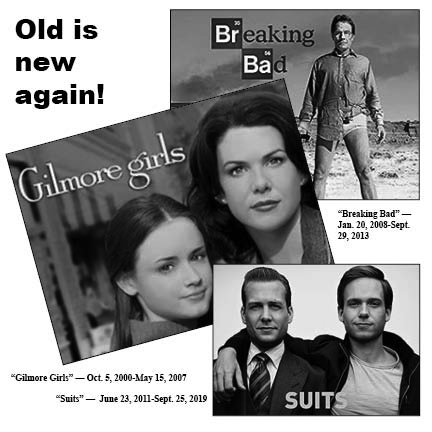By ELY NOBLE
Senior Reporter
In a world where there are new movies and shows released almost daily, comes the same world where older TV shows are making a comeback across all streaming platforms. Series like “Suits,” “Breaking Bad” and “Gilmore Girls” have come back into the spotlight, sitting at the top of Netflix’s charts, years after their original shows ended.
So, what’s driving this comeback of “old” content? A mix of nostalgia, smart business decisions and shifting viewer preferences is giving these classic shows a new taste of life.
One of the main reasons for this comeback is a shift in strategy by streaming platforms. Over the past year, big platforms like Netflix and Hulu have started to dial back their production of new original and turning back to older content. This shift was accelerated by the recent WGA and SAG-AFTRA strikes, which disrupted production schedules and forced platforms to dig into what has already had success.
“There’s a lot less risk in promoting a show that’s already been successful,” said media analyst Chase Brown. “Streamers can tap into the built-in fan bases of these shows, offering content that feels new to a younger audience who may have missed it when it first aired.”
But it’s not just about playing it safe. For streaming platforms, it’s also about money. Producing original shows can be expensive, especially with increasing competition. Licensing older shows is a much cheaper option that still provides hours of content to subscribers.
“It’s a win-win,” Brown said. “Older shows have multiple seasons that people can binge, keeping them subscribed longer. And the platforms get more content for less money.”
Nostalgia also plays a huge role in this trend. For many viewers, there’s something relaxing about watching shows they’ve seen before, especially during uncertain times. This was especially true during the COVID-19 pandemic when people craved the familiarity of old favorites. Even younger audiences are now discovering these older shows for the first time.
“I love watching shows from the ’90s and early 2000s,” said Bracen Lewis, health and sports science education major. “There’s something comforting about the pacing and style of older TV, and it’s fun to see what things were like back then.”
What counts as “old” is often more recent than expected. While some consider shows from the ’80s and ’90s as classic, many of the shows that are currently dominating streaming charts ended within the last decade. “Suits” for instance, originally aired from 2011 to 2019 but found a new audience when it hit Netflix.
“We’re seeing people discover recent hits they might’ve missed, as well as rewatching old favorites,” Brown said.
Still, the question remains, how long can old TV feel new again? “While nostalgia is powerful, viewers will eventually want fresh content,” Brown said. To keep things exciting, streaming services are starting to introduce remastered versions of older shows or develop spinoffs to appeal to both longtime fans and new viewers.
Ultimately, the return of older TV shows on streaming platforms is smart business moves, less expensive and the timeless appeal of nostalgia. As long as viewers enjoy rewatching previously loved shows, and new audiences keep finding them for the first time, older television will likely remain a major part of many streaming platforms.

